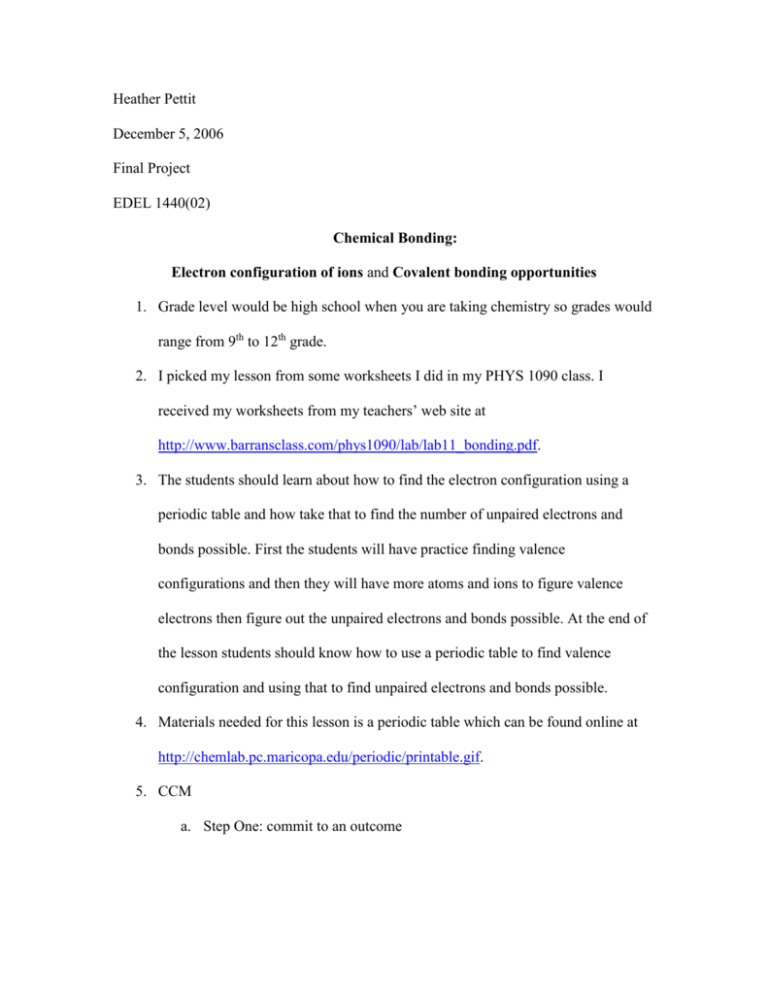Heather's final lesson
advertisement

Heather Pettit December 5, 2006 Final Project EDEL 1440(02) Chemical Bonding: Electron configuration of ions and Covalent bonding opportunities 1. Grade level would be high school when you are taking chemistry so grades would range from 9th to 12th grade. 2. I picked my lesson from some worksheets I did in my PHYS 1090 class. I received my worksheets from my teachers’ web site at http://www.barransclass.com/phys1090/lab/lab11_bonding.pdf. 3. The students should learn about how to find the electron configuration using a periodic table and how take that to find the number of unpaired electrons and bonds possible. First the students will have practice finding valence configurations and then they will have more atoms and ions to figure valence electrons then figure out the unpaired electrons and bonds possible. At the end of the lesson students should know how to use a periodic table to find valence configuration and using that to find unpaired electrons and bonds possible. 4. Materials needed for this lesson is a periodic table which can be found online at http://chemlab.pc.maricopa.edu/periodic/printable.gif. 5. CCM a. Step One: commit to an outcome i. How do you think you may find valence electrons? Do you think that unpaired electrons and bonds possible have anything in common? b. Step Two: expose beliefs i. You may talk in amongst yourself in your groups for a few minutes on what you may think about your beliefs on what we will do in these activities. c. Step Three: confront beliefs i. You may now try and work on these worksheets in groups and use what you have for resources in the classroom or the computers to try and help you do the first two. d. Step Four: accommodate the concept i. Now that you have done a few on your own I will now help you understand this concept and help you do two, to show how it is done. e. Step Five: extend the concept i. Ask the students what they can now use this information for later on in our activities that will deal with chemistry. f. Step Six: go beyond i. Ask all students if they are comfortable or if they would like more work to do with this concept. Recap what was learned about valence electrons and unpaired electrons and bonds possible. 6. A rubric on how I would assess the student’s learning of the main concept would have them do the worksheets and turn them in for a grade and I would give 1 point for each one right. Name: ________________________ Classroom Activities: Chemical Bonding Activity 1: Electron configurations of ions Write down the valence electron configurations of the neutral atoms and ions in the table below. Atom Valence Configuration Ion Na Na+ Mg Mg2+ O O2- F F- K K+ Ca Ca2+ Cs Cs+ Sr Sr2+ S S2- I I- Valence Configuration Activity 2: Covalent bonding opportunities For each atom or ion below, determine the number of its valence electrons, portion them as evenly as possible to the four valence orbitals on a dot diagram, identify the number of unpaired electrons, and predict the number of covalent bonds the atom or ion can make. Atom or ion Number of Valence Electrons Dot Diagram S S H H B B C C O O O- O Cl Cl P P Ca2+ Ca Unpaired electrons Bonds possible






